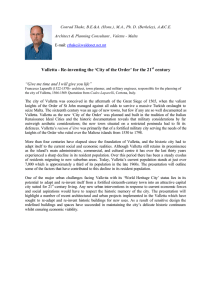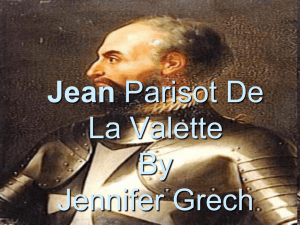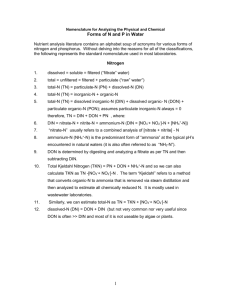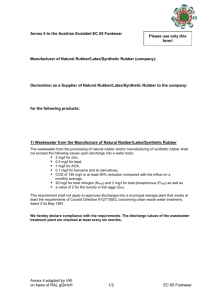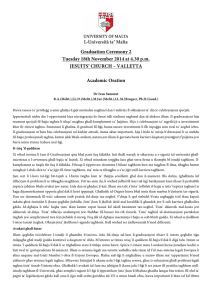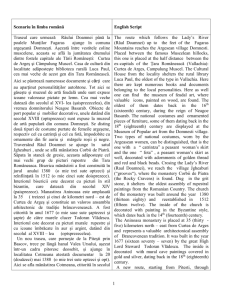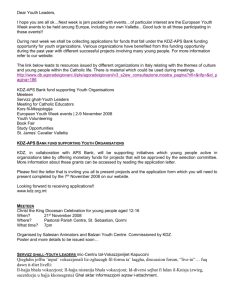OUR LADY OF VICTORY CHURCH
advertisement
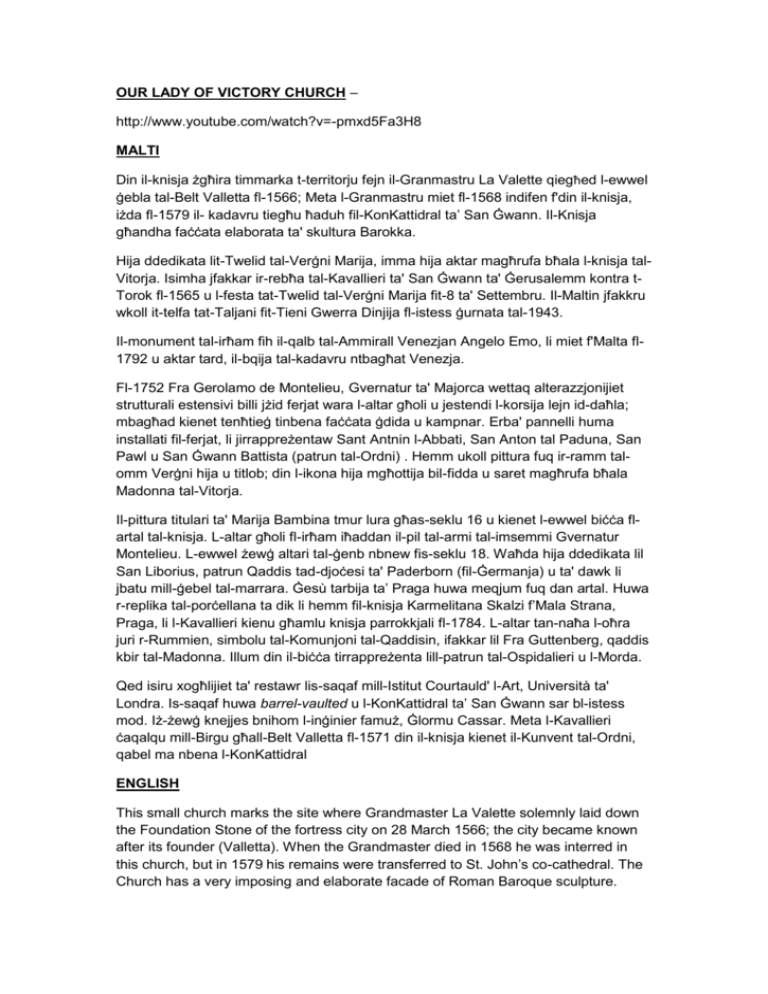
OUR LADY OF VICTORY CHURCH – http://www.youtube.com/watch?v=-pmxd5Fa3H8 MALTI Din il-knisja żgħira timmarka t-territorju fejn il-Granmastru La Valette qiegħed l-ewwel ġebla tal-Belt Valletta fl-1566; Meta l-Granmastru miet fl-1568 indifen f'din il-knisja, iżda fl-1579 il- kadavru tiegħu ħaduh fil-KonKattidral ta’ San Ġwann. Il-Knisja għandha faċċata elaborata ta' skultura Barokka. Hija ddedikata lit-Twelid tal-Verġni Marija, imma hija aktar magħrufa bħala l-knisja talVitorja. Isimha jfakkar ir-rebħa tal-Kavallieri ta' San Ġwann ta' Ġerusalemm kontra tTorok fl-1565 u l-festa tat-Twelid tal-Verġni Marija fit-8 ta' Settembru. Il-Maltin jfakkru wkoll it-telfa tat-Taljani fit-Tieni Gwerra Dinjija fl-istess ġurnata tal-1943. Il-monument tal-irħam fih il-qalb tal-Ammirall Venezjan Angelo Emo, li miet f'Malta fl1792 u aktar tard, il-bqija tal-kadavru ntbagħat Venezja. Fl-1752 Fra Gerolamo de Montelieu, Gvernatur ta' Majorca wettaq alterazzjonijiet strutturali estensivi billi jżid ferjat wara l-altar għoli u jestendi l-korsija lejn id-daħla; mbagħad kienet tenħtieġ tinbena faċċata ġdida u kampnar. Erba' pannelli huma installati fil-ferjat, li jirrappreżentaw Sant Antnin l-Abbati, San Anton tal Paduna, San Pawl u San Ġwann Battista (patrun tal-Ordni) . Hemm ukoll pittura fuq ir-ramm talomm Verġni hija u titlob; din l-ikona hija mgħottija bil-fidda u saret magħrufa bħala Madonna tal-Vitorja. Il-pittura titulari ta' Marija Bambina tmur lura għas-seklu 16 u kienet l-ewwel biċċa flartal tal-knisja. L-altar għoli fl-irħam iħaddan il-pil tal-armi tal-imsemmi Gvernatur Montelieu. L-ewwel żewġ altari tal-ġenb nbnew fis-seklu 18. Waħda hija ddedikata lil San Liborius, patrun Qaddis tad-djoċesi ta' Paderborn (fil-Ġermanja) u ta' dawk li jbatu mill-ġebel tal-marrara. Ġesù tarbija ta’ Praga huwa meqjum fuq dan artal. Huwa r-replika tal-porċellana ta dik li hemm fil-knisja Karmelitana Skalzi f’Mala Strana, Praga, li l-Kavallieri kienu għamlu knisja parrokkjali fl-1784. L-altar tan-naħa l-oħra juri r-Rummien, simbolu tal-Komunjoni tal-Qaddisin, ifakkar lil Fra Guttenberg, qaddis kbir tal-Madonna. Illum din il-biċċa tirrappreżenta lill-patrun tal-Ospidalieri u l-Morda. Qed isiru xogħlijiet ta' restawr lis-saqaf mill-Istitut Courtauld' l-Art, Università ta' Londra. Is-saqaf huwa barrel-vaulted u l-KonKattidral ta’ San Ġwann sar bl-istess mod. Iż-żewġ knejjes bnihom l-inġinier famuż, Ġlormu Cassar. Meta l-Kavallieri ċaqalqu mill-Birgu għall-Belt Valletta fl-1571 din il-knisja kienet il-Kunvent tal-Ordni, qabel ma nbena l-KonKattidral ENGLISH This small church marks the site where Grandmaster La Valette solemnly laid down the Foundation Stone of the fortress city on 28 March 1566; the city became known after its founder (Valletta). When the Grandmaster died in 1568 he was interred in this church, but in 1579 his remains were transferred to St. John’s co-cathedral. The Church has a very imposing and elaborate facade of Roman Baroque sculpture. It is dedicated to the Birth of the Blessed Virgin, but commonly known as the church of Our Lady of Victory. The name recalls the victory of the Knights Hospitallers of St. John of Jerusalem against the Muslim Turks in 1565 on the feast day of the Nativity of the Blessed Virgin on the 8th of September. The Maltese also recall Italy’s surrender during World War Two on the same day in 1943. The marble monument contains the heart of the Venetian admiral Angelo Emo, who died in Malta in 1792 and whose other mortal remains were conveyed to Venice. In 1752 Fra Gerolamo de Montelieu, Bailiff of Majorca carried out extensive structural alterations by adding an apse behind the high altar and extending the nave towards the entrance; it then became necessary to build a new facade and belfry. Four panels are installed in the apse, which represent St Anthony the Abbot, St Anthony of Paduna, St John the Baptist (patron of the Order) and St Paul. There is also a painting on copper of the Virgin mother in the act of praying; this icon clad with embossed silver work subsequently became known as Our Lady of Victory. The titular painting of the Nativity of Our Lady dates back to the 16th century and was the first altar-piece of the church. The high altar in fine marble bears the coat of arms of the said Bailiff Montelieu. The first two side-altars were erected in the 18th century. One is dedicated to St Liborius, patron Saint of the diocese of Paderborn (Germany) and of those suffering from gall stone. The infant Jesus of Prague is venerated on this altar. It is a porcelain replica of the one at the Discalced Carmelite church in Mala Strana, Prague, which the Knights administered parish church in 1784. The other side altar showing pomegranates, symbol of the Communion of Saints, recalls Fra Guttenberg, a big devotee of the Blessed Virgin. The present altar-piece represents St John of God, patron of Hospitallers and the Sick. Restoration works on the ceiling are being carried out presently by the Courtauld Institute of Art, University of London. The ceiling is barrel-vaulted and St. John’s church was modelled in the same way. Both churches were built by the famous engineer, Gerolamo Cassar. When the Knights moved from Birgu to Valletta in 1571 this church served at first as the conventual church of the Order, before St. John’s was built. SUMMARY + CULTURAL NOTES This small church marks the site where Grandmaster La Valette laid down the first stone of the Capital City. The Church has a very imposing and elaborate facade of Roman Baroque sculpture. It is dedicated to the Birth of the Blessed Virgin, but is commonly known as the church of Our Lady of Victory. The church is well renowned because present is the heart of the Venetian admiral Angelo Emo, who died in Malta in 1792 and whose other mortal remains were conveyed to Venice. The Knights of St John used to pray in this Church very often, who also used it as a convent in the 16th Century. Restoration works on the ceiling are being carried out presently by the Courtauld Institute of Art, University of London. The ceiling is barrel-vaulted and St. John’s church was modelled in the same way. Both churches were built by the famous Maltese engineer, Gerolamo Cassar. EUROPEAN FRAMEWORK OF LANGUAGE: C1 Effective User
